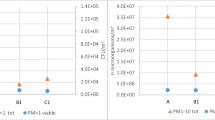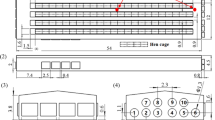Abstract
Composting plants are regarded as one of the important sources of environmental bioaerosols. However, limitations in the size distribution of airborne bacteria have prevented our comprehensive understanding of their risk to human health and their dispersal behavior. In this study, different sizes of airborne bacteria were collected using an eight-stage impactor from a full-scale composting facility. Size-related abundance and communities of airborne bacteria as well as human pathogenic bacteria (HPB) were investigated using 16S rRNA gene sequencing coupled with droplet digital PCR. Our results indicate that the bacterial concentrations from the eight stages were approximately 104–105copies/m3. Although no statistical correlation was detected between the particle size and the Shannon index, the influence of size on bacterial lineages was observed in both composting and packaging areas. For airborne bacteria from different stages, the dominant phyla were Firmicutes, Proteobacteria, and Actinobacteria, and the dominant genera was Bacillus. Seven out of eight HPB with a small geometric mean aerodynamic diameter had a high concentration in composting areas. Based on diameters of 2.42 to 5.09 µm, most HPB in the composting areas were expected to be deposited on the bronchus and secondary bronchus. However, in the packaging areas, the deposition of HPB (diameters 3.70 to 8.96 µm) occurred in the upper part of the respiratory tract. Our results on the size distribution, abundance, and diversity of these bacteria offer important information for the systematic evaluation of bacterial pathogenicity and the potential health impacts on workers in composting plants and the surrounding residents.

Similar content being viewed by others
References
Bonifait L, Marchand G, Veillette M, Mbareche H, Dubuis M E, Pépin C, Cloutier Y, Bernard Y, Duchaine C (2017). Workers’ exposure to bioaerosols from three different types of composting facilities. Journal of Occupational and Environmental Hygiene, 14(10): 815–822
Byeon J H, Park C W, Yoon K Y, Park J H, Hwang J (2008). Size distributions of total airborne particles and bioaerosols in amunicipal composting facility. Bioresource Technology, 99(11): 5150–5154
Cormier Y, Tremblay G U Y, Meriaux A, Brochu G, Lavoie J (1990). Airborne microbial contents in two types of swine confinement buildings in Quebec. American Industrial Hygiene Association Journal, 51(6): 304–309
Di Filippo P, Pomata D, Riccardi C, Buiarelli F, Castellani F, Calitri G, Simonetti G, Sonego E, Bruni E, Uccelletti D (2020). Concentrations of bacteria and bacterial and fungal spores calculated from chemical tracers associated with size-segregated aerosol in a composting plant. Air Quality, Atmosphere & Health, 13(4): 469–476
Dickson R P, Huffnagle G B (2015). The Lung Microbiome: New principles for respiratory bacteriology in health and disease. PLoS Pathogens, 11(7): e1004923
Pagans E, Barrena R, Font X, Sánchez A (2006). Ammonia emissions from the composting of different organic wastes. Dependency on process temperature. Chemosphere, 62(9): 1534–1542
Galès A, Bru-Adan V, Godon J J, Delabre K, Catala P, Ponthieux A, Chevallier M, Birot E, Steyer J P, Wéry N (2015). Predominance of single bacterial cells in composting bioaerosols. Atmospheric Environment, 107: 225–232
Gao M, Jia R, Qiu T, Han M, Song Y, Wang X (2015). Seasonal size distribution of airborne culturable bacteria and fungi and preliminary estimation of their deposition in human lungs during non-haze and haze days. Atmospheric Environment, 118: 203–210
Gao M, Jia R, Qiu T, Han M, Wang X (2017). Size-related bacterial diversity and tetracycline resistance gene abundance in the air of concentrated poultry feeding operations. Environmental Pollution, 220, Part B: 1342–1348
Gao M, Qiu T, Sun Y, Wang X (2018). The abundance and diversity of antibiotic resistance genes in the atmospheric environment of composting plants. Environment International, 116: 229–238
Gutarowska B, Szulc J, Nowak A, Otlewska A, Okrasa M, Jachowicz A, Majchrzycka K (2018). Dust at various workplaces–microbiological and toxicological threats. International Journal of Environmental Research and Public Health, 15(5): 877–895
Holt J G, Krieg N R, Sneath P H A, Staley J T, Williams S T (1994). Bergey’s manual of determinative bacteriology. Baltimore: Williams and Wilkins, 385–1161
Hong P Y, Li X, Yang X, Shinkai T, Zhang Y, Wang X, Mackie R I (2012). Monitoring airborne biotic contaminants in the indoor environment of pig and poultry confinement buildings. Environmental Microbiology, 14(6): 1420–1431
Just N, Kirychuk S, Gilbert Y, Létourneau V, Veillette M, Singh B, Duchaine C (2011). Bacterial diversity characterization of bioaerosols from cage-housed and floor-housed poultry operations. Environmental Research, 111(4): 492–498
Lelieveld J, Evans J S, Fnais M, Giannadaki D, Pozzer A (2015). The contribution of outdoor air pollution sources to premature mortality on a global scale. Nature, 525(7569): 367–371
Liu H, Zhang X, Zhang H, Yao X, Zhou M, Wang J, He Z, Zhang H, Lou L, Mao W, Zheng P, Hu B (2018). Effect of air pollution on the total bacteria and pathogenic bacteria in different sizes of particulate matter. Environmental Pollution, 233: 483–493
Liu Q Q, Li M, Liu R, Zhang Q, Wu D, Zhu D, Shen X H, Feng C P, Zhang F W, Liu X (2019). Removal of trimethoprim and sulfamethoxazole in artificial composite soil treatment systems and diversity of microbial communities. Frontiers of Environmental Science & Engineering, 13(2): 28
Mbareche H, Brisebois E, Veillette M, Duchaine C (2017). Bioaerosol sampling and detection methods based on molecular approaches: No pain no gain. Science of the Total Environment, 599–600: 2095–2104
Mbareche H, Veillette M, Bilodeau G J, Duchaine C (2019). Fungal aerosols at dairy farms using molecular and culture techniques. Science of the Total Environment, 653: 253–263
Nazaroff W W (2004). Indoor particle dynamics. Indoor Air, 14(Suppl 7): 175–183
Peng J,WangK, Yin X B, Yin X Q, Du M F, Gao Y Z, Antwi P, Ren N Q, Wang A J (2019). Trophic Mode and Organics Metabolic Characteristic of Fungal Community in Swine Manure Composting. Frontiers of Environmental Science & Engineering, 13(6): 93
Qian X, Sun W, Gu J, Wang X J, Zhang Y J, Duan M L, Li H C, Zhang R R (2016). Reducing antibiotic resistance genes, integrons, and pathogens in dairy manure by continuous thermophilic composting. Bioresource Technology, 220: 425–432
Reponen T A, Gazenko S V, Grinshpun S A, Willeke K, Cole E C (1998). Characteristics of airborne Actinomycete spores. Applied and Environmental Microbiology, 64(10): 3807–3812
Robertson S, Douglas P, Jarvis D, Marczylo E (2019). Bioaerosol exposure from composting facilities and health outcomes in workers and in the community: A systematic review update. International Journal of Hygiene and Environmental Health, 222(3): 364–386
Robine E, Dérangère D, Robin D (2000). Survival of a Pseudomonas fluoresceins and Enterococcus faecalis aerosol on inert surfaces. International Journal of Food Microbiology, 55(1–3): 229–234
Sykes P, Jones K, Wildsmith J D (2007). Managing the potential public health risks from bioaerosol liberation at commercial composting sites in the UK: An analysis of the evidence base. Resources, Conservation and Recycling, 52(2): 410–424
Taha M P M, Pollard S J T, Sarkar U, Longhurst P (2005). Estimating fugitive bioaerosol releases from static compost windrows: feasibility of a portable wind tunnel approach. Waste Management (New York, N.Y.), 25(4): 445–450
Tellier R (2006). Review of aerosol transmission of influenza A virus. Emerging Infectious Diseases, 12(11): 1657–1662
Thomas R J, Webber D, Sellors W, Collinge A, Frost A, Stagg A J, Bailey S C, Jayasekera P N, Taylor R R, Eley S, Titball R W (2008). Characterization and deposition of respirable large- and small-particle bioaerosols. Applied and Environmental Microbiology, 74(20): 6437–6443
Veillette M, Bonifait L, Mbareche H, Marchand G, Duchaine C (2018). Preferential aerosolization of Actinobacteria during handling of composting organic matter. Journal of Aerosol Science, 116: 83–91
Walser S M, Gerstner D G, Brenner B, Bünger J, Eikmann T, Janssen B, Kolb S, Kolk A, Nowak D, Raulf M, Sagunski H, Sedlmaier N, Suchenwirth R, Wiesmüller G, Wollin K M, Tesseraux I, Herr C E W (2015). Evaluation of exposure-response relationships for health effects of microbial bioaerosols: A systematic review. International Journal of Hygiene and Environmental Health, 218(7): 577–589
Yamamoto N, Bibby K, Qian J, Hospodsky D, Rismani-Yazdi H, Nazaroff W W, Peccia J (2012). Particle-size distributions and seasonal diversity of allergenic and pathogenic fungi in outdoor air. ISME Journal, 6(10): 1801–1811
Acknowledgements
This work was supported by the Beijing Agriculture Innovation Consortium (Grant No. BAIC04-2020), the Research Foundation of BAAFS (Grant No. KJCX20200402), the National Natural Science Foundation of China (Grant Nos. 51878053, 41961134033), the Beijing Natural Science Foundation (Grant No. 6182019), the Key Research and Development Program of Ningxia Autonomous Region (Grant No. 2019BFG02015), and the National Key R&D Plan (Grant Nos. 2016YFD0800205, 2017YFD0801402).
Author information
Authors and Affiliations
Corresponding authors
Additional information
Highlights
• Bacterial concentrations from eight stages were 104–105copies/m3.
• Diameter influenced clustering of bacterial and HPB lineages.
• Dg of 8 HPB ranged from 2.42 to 5.09 µm in composting areas.
• Dg of 8 HPB ranged from 3.70 to 8.96 µm in packaging areas.
• HPB had high concentrations and small sizes in composting areas.
Special Issue—Bioaerosol, Environment and Health
Supplemental Materials
Rights and permissions
About this article
Cite this article
Gao, M., Yang, Z., Guo, Y. et al. The size distribution of airborne bacteria and human pathogenic bacteria in a commercial composting plant. Front. Environ. Sci. Eng. 15, 39 (2021). https://doi.org/10.1007/s11783-020-1356-4
Received:
Revised:
Accepted:
Published:
DOI: https://doi.org/10.1007/s11783-020-1356-4




